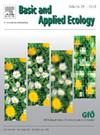野花播种作为德国葡萄园传统行间绿化的替代方案
IF 3.5
2区 环境科学与生态学
Q2 ECOLOGY
引用次数: 0
摘要
由于集约化的农业实践和较低的植物物种多样性,大多数欧洲葡萄园对生物多样性保护的贡献很小,这些物种多样性对传粉昆虫等有益昆虫的支持潜力很低。根据特定的植物性状,我们选择了37种牧草和1种草,分别于2020年秋季和2021年春季在德国的11个葡萄园(生物多样性葡萄园)的行间播种。其目的是增加本地植物的多样性,并为葡萄园工作提供足够的植被覆盖。为了进行比较,我们选择了六个采用传统绿化的葡萄园(对照葡萄园)。在生物多样性和对照葡萄园中,我们记录了2021年至2023年所有植物物种的覆盖和数量以及裸土的覆盖。此外,我们还计算了传粉者取食指数(PFI),以评估和比较在生物多样性和控制行间出现的播种和自生草本物种作为传粉者食物来源的潜力。在38种播种品种中,36种在生物多样性葡萄园中建立。在播种后的第一年,用新混合种子播种的葡萄园行间显示出与传统绿化的葡萄园行间相当的植被覆盖,从而确保了葡萄园工作的适用性。此外,生物多样性葡萄园的牧草盖度和物种数量显著高于对照葡萄园,而对照葡萄园的牧草盖度显著高于对照葡萄园。我们观察到,与对照葡萄园相比,生物多样性葡萄园的PFI值显著更高。引进的植物不仅增加了植物的多样性,而且可能是传粉昆虫的重要花蜜和花粉来源。然而,自发建立的植物物种也对PFI有贡献,特别是在春季和初夏。由于使用高多样性混合种子的好处,作为农业环境计划的一部分,建议补贴使用野生植物进行葡萄园绿化。本文章由计算机程序翻译,如有差异,请以英文原文为准。
Wildflower sowings as alternative for conventional inter-row greening in German vineyards
Most European vineyards contribute little to biodiversity preservation due to intensive agricultural practices and a low plant species diversity that has low potential to support benefical insects such as pollinators. Based on specific plant traits, we selected 37 forbs and one grass species, sowing them in the inter-rows of 11 vineyards (biodiversity vineyards) in Germany in autumn 2020 and spring 2021. The aim was to increase native plant diversity and to provide a sufficient vegetation cover for vineyard work. For comparison, we used six vineyards with conventionally greened inter-rows (control vineyards). In both the biodiversity and control vineyards, we recorded the cover and number of all plant species as well as the cover of bare soil in the years 2021 to 2023. Furthermore, we calculated the Pollinator Feeding Index (PFI) to assess and compare the potential of sown and spontaneously emerging forb species occurring in the biodiversity and control inter-rows as food sources for pollinators. Of the 38 sown species, 36 established in the biodiversity vineyards. Already in the first year after sowing, vineyard inter-rows sown with the new seed mixture showed comparable vegetation cover as conventionally greened vineyard inter-rows, thus ensuring suitability for vineyard work. In addition, we found significantly higher forb cover and species number within the biodiversity vineyards, while the control vineyards showed a significantly higher grass cover. We observed significantly higher PFI values in the biodiversity vineyards as compared to the control vineyards. The introduced plant species did not only increase plant diversity, but could also be an important nectar and pollen source for pollinating insects. However, spontaneously established plant species also contributed to the PFI, especially in spring and early summer. Due to the benefits of using high-diversity seed mixtures, subsidizing the use of wild plants for vineyard greening as part of agri-environmental schemes is recommended.
求助全文
通过发布文献求助,成功后即可免费获取论文全文。
去求助
来源期刊

Basic and Applied Ecology
环境科学-生态学
CiteScore
6.90
自引率
5.30%
发文量
103
审稿时长
10.6 weeks
期刊介绍:
Basic and Applied Ecology provides a forum in which significant advances and ideas can be rapidly communicated to a wide audience. Basic and Applied Ecology publishes original contributions, perspectives and reviews from all areas of basic and applied ecology. Ecologists from all countries are invited to publish ecological research of international interest in its pages. There is no bias with regard to taxon or geographical area.
 求助内容:
求助内容: 应助结果提醒方式:
应助结果提醒方式:


